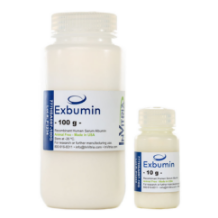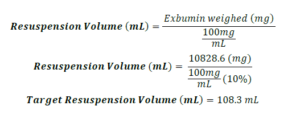- Home
- Exbumin – Reconstitution Application Note
Exbumin – Reconstitution Application Note
Published on 3 February 2022
Workflow Summary
Weigh Exbumin (lyophilized powder) and determine final total volume of the solution. Add 70% of the final volume of DPBS, PBS, or basal media. Allow the solution to set for 12 hours at 4°C. Adjust the volume to account for volume increase from powder. Sterile filter and store at 2-8°C or freeze at -20°C for long term storage.

Introduction
Exbumin® is a recombinant human serum albumin that is manufactured using good manufacturing practices at an ISO9001:2015 certified facility in Kansas, USA. It is blood-free and has been used in hundreds of thousands of injections.
Exbumin is one of the few excipients available to improve viral stability for vaccines and gene therapies. Exbumin is also used to maintain tissue viability during cryo-preservation or storage. In addition, Exbumin is used to stabilize cells and tissues used in cell therapy and regenerative medicine applications. Exbumin has been approved for use as an excipient in injectable therapeutics by regulatory agencies.
Materials Needed
Recombinant Human Serum Albumin
- Exbumin (InVitria 777HSA097)
Reconstitution Supplies
- 125 mL sterile PETG media bottle (ThermoFisher 2019-0125)
- Cell culture grade DPBS, PBS or basal media, such as DMEM F/12, DMEM, MEM, RPMI
Vacuum Filtration System
- 500 ml 0.2 micron vacuum filtration system (Millipore SCGPU05RE)
Protocol:
Exbumin Stock Preparation
- To prepare a sterile, 10% concentrated liquid stock solution of Exbumin, first weigh an empty, 125 ml Sterile PETG Media Bottle.
- Under a laminar flow hood, add 10 g Exbumin to the bottle. Weigh the bottle containing the powder to determine the actual weight of Exbumin added.
- Once the exact weight of Exbumin is known, calculate the volume required to produce a 10% concentration of Exbumin. Then, gently reconstitute the powder in cell-culture grade DPBS, PBS, or the selected basal media by adding 70% of the calculated final volume directly to the 125 ml bottle. Do not add the full final volume of buffer at this stage. Account for volume displacement caused by the powder when calculating the final volume.
- Cap the 125 ml bottle and gently turn it on its side to allow the powdered albumin to fall into the buffer. Avoid the formation of bubbles during this step. Return the container upright and allow the albumin to dissolve, undisturbed (no shaking) at 4°C in the dark for a minimum of 4 hours and preferably overnight.
- Once all the powdered Exbumin has dissolved, bring the volume up to the calculated target by adding additional reconstituted liquid. To achieve this easily, use a 50 ml pipette to move exactly 50 ml of the reconstituted albumin powder to a fresh 125 ml bottle. Using the same pipette, remove the remaining liquid from the original bottle, noting the volume. Finally, pipette the difference between the target volume and the volume as measured by pipetting and add this volume of reconstitution liquid to the new bottle.
- Sterilize the stock solution by filtering through an 0.2 µm vacuum-driven disposable filtration system.
Optional
- For manual filtration, InVitria recommends using a 25 mm, 0.8 µm filter (Pall 4188), followed by a 0.2 µm 30-mm PES low-protein-binding filter (Celltreat 229747), using a sterile Luer-lock syringe (Medline SYR103010H).
Example Calculations
Footnotes
- Francis GL. Albumin and mammalian cell culture: implications for biotechnology applications. 2010;62(1):1-16. https://doi.org/10.1007/s10616-010- 9263-3
- He XM, Carter Atomic structure and chemistry of human serum albumin. Nature. 1992;358(6383):209-215. https://doi.org/10.1038/358209a0
- Taverna M, Marie AL, Mira JP, Guidet Specific antioxidant properties of human serum albumin. Ann Intensive Care. 2013;3(1):4. https://doi.org/10.1186/2110-5820-3-4
- Maude SL, Teachey DT, Porter DL, Grupp CD19-targeted chimeric antigen receptor T-cell therapy for acute lymphoblastic leukemia. Blood. 2015;125(26):4017-
- https://doi.org/10.1182/blood-2014-12-580068
- Trounson A, Thakar RG, Lomax G, Gibbons Clinical trials for stem cell therapies. BMC Med. 2011;9:52. https://doi.org/10.1186/1741-7015-9-52
- Cavazzana-Calvo M, Hacein-Bey S, de Saint Basile G et al. Gene therapy of human severe combined immunodeficiency (SCID)-X1 Science. 2000;288(5466):669- 672.
- van der Valk J, Brunner D, De Smet K et al. Optimization of chemically defined cell culture media–replacing fetal bovine serum in mammalian in vitro Toxicol In Vitro. 2010;24(4):1053-1063. https://doi.org/10.1016/j.tiv.2010.03.016
- Blázquez-Prunera A, Díez JM, Gajardo R, Grancha Human mesenchymal stem cells maintain their phenotype, multipotentiality, and genetic stability when cultured using a defined xeno-free human plasma fraction. Stem Cell Res Ther.
2017;8(1):103. https://doi.org/10.1186/s13287-017-0552-z
- Chisini LA, Conde MCM, Grazioli G et Venous Blood Derivatives as FBS-Substitutes for Mesenchymal Stem Cells: A Systematic Scoping Review. Braz Dent J. 2017;28(6):657-668. https://doi.org/10.1590/0103-6440201701646
- Alfano RW. Albumin in cell culture media—an examination of quality and function. In: Brieva T, Miller W, Mason C, Scale-up and manufacturing of cell-based therapies
- ECI Symposium Series; 2017 https://dc.engconfintl.org/cellbasedtherapies_v/22
- Pennybaker A, Alfano Utilization of recombinant albumins in the expansion of human T lymphocytes. Cell Gene Ther Insights. 2018;4(4):231-239.
